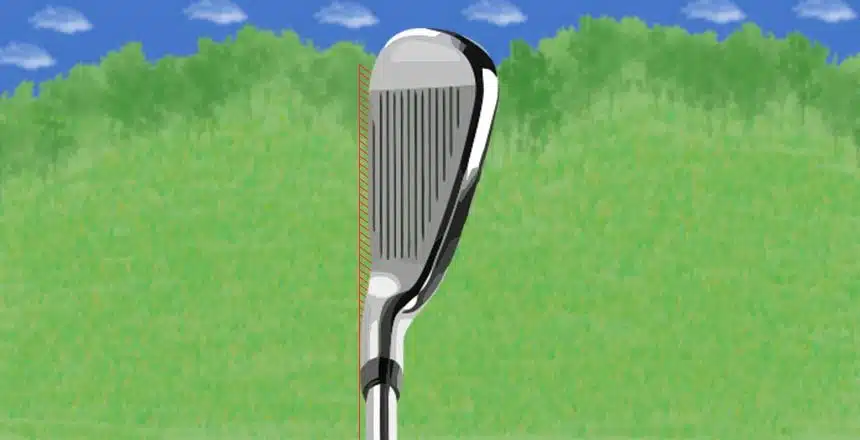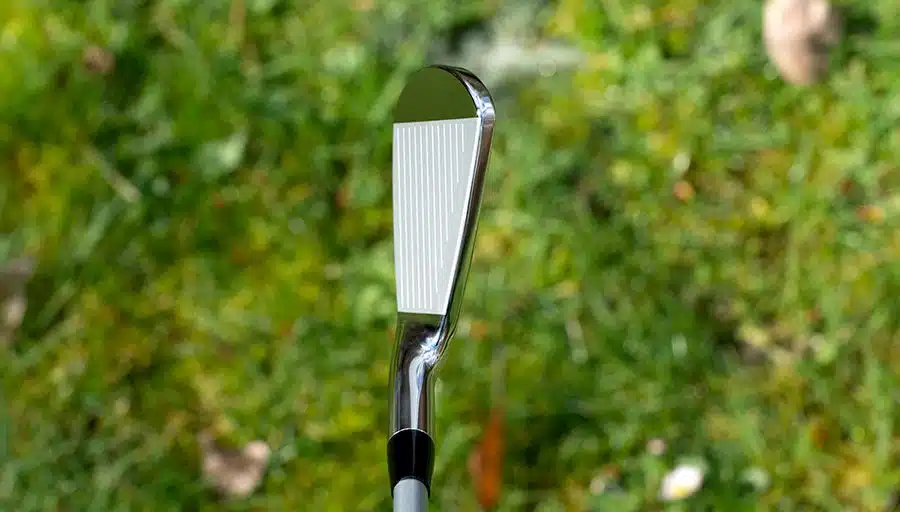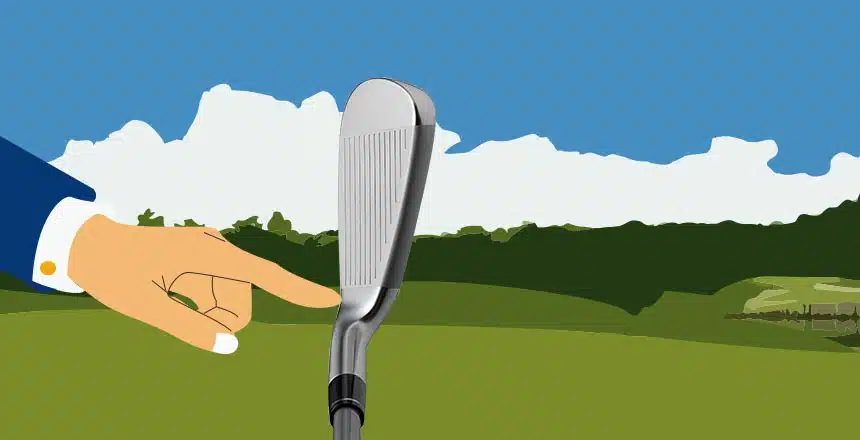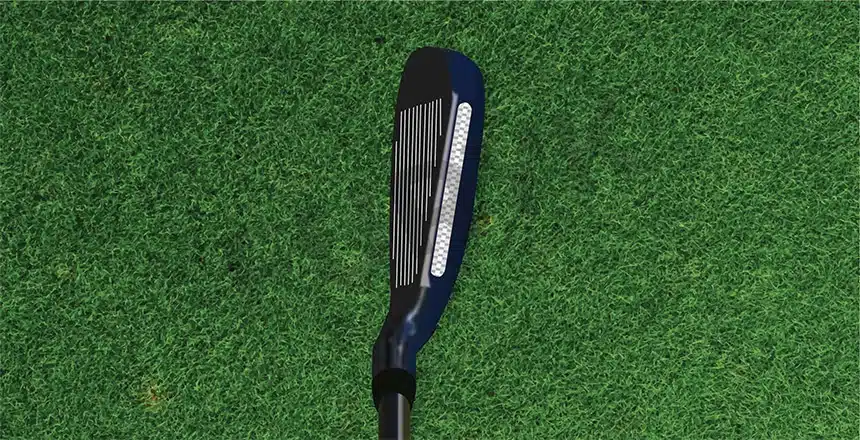With offset golf clubs, the face is positioned at the back of the shaft. So you get additional time to get the clubface to square up at just the right moment during impact. This is nothing but taking advantage of modern technology for correcting your slices and other chronic errors.
What is offset in golf clubs? If more golfers knew the correct answer to this, offset clubs would be sold even more. After all, an experienced player does feel intimidated when his/her opponent has one of these as a part of their golf club set.
In This Post
- What Does An Offset Golf Club Really Mean?
- So What Does An Offset Golf Club Do?
- Offset Golf Clubs – The Good and the Dark Side
- Now Let’s Compare Offset With Non-Offset Golf Clubs
- What About Golf Club Offset Measurement
- Offset Driver Explained
- Best Offset Drivers In Golf
- Offset Iron Explained
- Best Offset Irons In Golf
- Gripping An Offset Golf Club the Right Way
- Frequently Asked Questions About Golf Club Offset
- Wrapping It Up… So Then Does Offset Really Matter?
What Does An Offset Golf Club Really Mean?

When you hear the word ‘offset’ in golf, know that it means that the golf club’s leading edge is placed behind the shaft. With an offset hosel, the part that connects the shaft to the clubhead is bent (hence, behind the shaft).
Offset in golf clubs was actually only introduced for putters (in the 1800s). For the simple reason to encourage you to get your hands forward first before the club. But then now there are plenty of offset drivers and irons too that you can correct your swing flaws with.
A simpler explanation if you need one…
Offset is when the clubhead hosel or neck is placed first and then behind that there’s the clubface. So the forward part of the clubhead hosel/neck is in front of the bottom part of the clubface.
So What Does An Offset Golf Club Do?
Your hands are supposed to lead the way during your swing. Because only that way can the golf ball launch easily and high into the air. But then when your hands don’t lead the way, it means your clubhead is doing that. Meaning the golf club is AHEAD of your hands.
So with an offset hosel, you’re literally in a better position to get those hands of yours to the golf ball first and then the club. Therefore, the possibility of not achieving proper launch conditions and/or producing thin shots is minimized drastically if not eliminated completely.
Offset Golf Clubs – The Good and the Dark Side
1. Offset is Good Because It Squares Clubface At Impact
It’s precisely why golf clubs, particular drivers are offset in the first place – to reduce your likelihood of hitting a slice. In the game of golf, slicing the ball means not being able to control factors like ball flight, spin, accuracy, etc. But with offset, the fact that you can get its clubface to square at impact in itself means less frequent slices.
It’s because your hands travel past the golf ball before the club does. And this adds more time into those seconds before impact for you to get into the right position that gets the clubface to square up.
However, please note that an offset hosel doesn’t really eliminate or fix the problem completely. It can do only so much as a cure but then offset golf drivers have proven to boost confidence, so you can hit more fairways.
2. Offset is Good Because It Increases Launch Angle
Nothing is complicated to understand when explained properly. So here’s the thing about offset clubs improving launch settings.
Modern golf equipment (golf clubs and golf balls), in general, are engineered for one purpose alone – flight. The goal is to strike high-towering shots and have them land softly as well.
But then the ability to do this also depends on how much spin you generate. Because it’s the spin rate, combined with advanced aerodynamics of course, that gets the ball to launch higher. And this WHOLE setup is the very essence of offset.
It’s achieved through slightly tweaking the way the shaft connects to the clubhead/clubface. With an offset hosel position, what’s guaranteed is a desirable combination of higher launch and penetrating ball flight.
3. Offset is Bad Because It’s Only A Temporary Anti-Slice Fix
A proper cure is more like actually fixing the problem in your golf swing that is making the ball slice in the first place. But many golfers want the easy way out to that common issue. And using an offset hosel is one effective way of fixing a slice quickly, so you can start to hit straighter in no time.
A more permanent solution, however, is to make use of offset to boost your confidence and, at the same time, work toward first “fixing your golf grip” since your hand positioning over your club directly controls the orientation of the clubface at impact. And second, also “correcting your golf swing sequence” because a ‘smooth’ transition into your downswing is a must.
Not boasting or anything but here’s a little dose of my Swing Evolution you might want to check out…
4. Offset is Bad Because It Might Lead to Over-Fixing
You know that an offset driver, iron, or any other golf club with an offset hosel is NOT for you if you’re reversing that fault of hooking/slicing the ball. Overdoing a shot is a clear indicator of that, no doubt.
The whole purpose of offset is to gain more time to correct your swing error, so you can square the clubface during impact no matter what. And once that begins to happen, your chances of eventually over-shooting become more and more likely.
Now Let’s Compare Offset With Non-Offset Golf Clubs
First off, let me bring to your attention that the degree of offset is not the same in all offset golf clubs. Just take a look at all the offset angles at address and you’ll instantly understand what I’m talking about. Mind you, you have to look closely and purposefully of course. You’ll see that the shaft of the club sits before the leading edge, that is ahead of the clubface.
But with the non-offset kind of golf clubs, you’re forced to get your hands to lead through a more aggressive approach during impact. The first few shots are doomed to be slappy and weak but then you eventually get used to the ‘non-offset’ feel with enough practice.
So here are the differences between the two experiences.
Offset Target Audience Is Beginners/Amateurs
I really don’t need to tell you that an offset design, since it has anti-slice properties, is a more fitting choice for new and casual golfers. Whereas non-offset works best for professional/experienced players who literally have better ball flight control.
Offset is Slightly Angled
It’s only natural for golf clubs with no offset hosel to be straight-shafted. Meaning the shaft right, from the grip of the club till the hosel, is straight. While an offset hosel is indeed off-ly set, meaning slightly angled to re-position the clubface’s leading edge.
Offset Overcomes Slices
Downswing angles brought about by the offset in golf clubs are the primary forces behind curing your slice, albeit only temporarily. So you end up hitting more fairway shots. On the other hand, you cannot expect this kind of slice-correcting performance with non-offset, regular golf clubs.
Offset Hand Positioning Is In the Front
The clubhead is behind your hands with offset while non-offset consists of hands positioned behind the clubhead.
What About Golf Club Offset Measurement
The offset begins from the extreme left of the golf club hosel till its leading edge. With more offset, in both drivers and irons, it means the clubhead is placed farther back. And this helps you to get a higher launch angle.
But then the level of offset is not the same with every offset golf club. The amount of offset actually depends on who the club is designed for and who the manufacturer is as well. This suggests that more offset is for golfers like beginners and high handicappers because little to no offset is popular among better players with a low handicap.
Also, longer offset golf clubs (longer shafts I mean), have more offset. And shorter clubs with offset (such as wedges and short irons) feature less offset.
As for the exact amount or level of offset, that is often mentioned by the golf club brand in the specifications of the product. Generally, the offset measurement unit is mm (millimeters), when it’s not decimals. More offset in irons is usually 5-8 mm. And it’s the putters that have the highest offset. Putter offset is typically labeled as half shaft, full shaft, or one-and-a-half shafts.
Offset Driver Explained

What Does It Do?
If your swing speed is below average, you should be using an offset driver to compensate for that. How does it compensate exactly? Once again, with an offset hosel, it becomes easier to square the clubface at impact. And with that in place, it doesn’t matter if you slice or hook your shot, that drive is sure to travel straighter nevertheless.
Obviously, getting to the bottom of things is important too. Such as fixing your actual swing flaw that is causing you to produce that misshapen shot.
How to Hold It?
The offset arrangement requires no special effort on your behalf – that’s the beauty of it all! Just hold an offset driver like you would any other non-offset golf driver. The goal here is for the offset hosel to, by default, help you hit more fairways with more confidence. So no need to change the way you grip the driver – change absolutely nothing!
How to Hit It?
Once again, hit an offset driver like it’s a regular, non-offset driver. If you have right-hand orientation, start by setting up with the golf ball and your left heel in line. Tilt the shoulders a bit to get the right one below the left. And then just rip it!
With offset drivers, the best part is that they build confidence when it comes to hitting more accurately and consistently. Aside from taking proper golf lessons of course to permanently fix the problem in your swing that’s actually causing the ball to slice/hook off the intended path.
Best Offset Drivers In Golf
1. Cobra Golf F-Max Driver
- Offset driver reduces rightward tendencies
- Lighter carbon crown head best for slow swing speeds
- Back/heel weighting for easier, higher launch
- Poor quality shaft
It’s really not uncommon for golfers to pick Cobra F-Max because of its ultimate offset hosel design. This offset corrects almost every right-biased flight, which makes it so much easier for you to find fairways more consistently.
It’s a very, very lightweight driver with a carbon crown clubhead and graphite shaft. So much forgiveness on off-center shots that you forget all about your slower swing speed. And let’s not forget about the higher launch as well that Cobra F-Max produces by default.
And you know what else helps with gaining more consistency and control? The answer – heel-inclined weighting!
2. Callaway Golf 2020 Mavrik MAX Driver
- Jailbreak technology produces faster ball speed
- Very strong yet lightweight clubface also for speed
- Adjustable weights optimize ball flight
- Lightweight UST Helium shaft maximizes forgiveness
- None to brood over
With Mavrik MAX by Callaway, struggling with hitting a driver becomes a thing of the past. This offset golf driver, for women by the way and that means Ladies-flex, is indeed the easiest to play in comparison to Mavrik Standard and Mavrik Sub Zero.
The Standard version is for all kinds of golfers while Sub Zero is for low-spin professionals. This means Mavrik MAX is more specifically designed for a particular problem, which is slicing the golf ball.
The driver is equipped with two interchangeable weights – one is for an anti-slice, draw-biased flight and the other for correcting mis-hits. Either way, you use less hand/arm power for making your drives travel a great deal of distance.
Just the ability to easily adjust this particular golf club is enough to prove that Callaway Mavrik MAX is a very powerful tool at one’s disposal.
3. Pinemeadow PGX Offset Golf Driver
- Large 460cc clubhead with large sweet spot (very forgiving)
- Anti-slice performance with shots that go straighter
- Clean, sleek aesthetics with matte black/white/green
- Matte finish scratches easily, poor overall durability
Negative feedback of Pinemeadow PGX’s offset or any other such golf driver with this kind of game-changing anti-slice technology, although I doubt there is a model like the PGX, shouldn’t be taken too seriously. And that’s because anti-slice or offset clubs don’t completely eliminate the slicing problem when you have a bad technique.
But the great news is that Pinemeadow PGX certainly knows how to reduce those slices down by half. The remainder half gets eliminated only once you correct the very flaw in your golf swing that’s causing the slice to begin with.
This club also has quite an expanded sweet spot, hence forgiveness on mis-hits that maximizes distance is also a sweet part of the deal.
Offset Iron Explained

What Does It Do?
Just like offset drivers, an offset iron also leaves a slightly wider gap for you to square the clubface. So you can take your iron shots with more confidence and achieve a more consistent and straighter ball flight, even when your swing speed is slower.
But with golf irons, moving up the set means the offset decreases. And that only makes sense because of the decrease in swing speed with shorter clubs. However, overall, an offset hosel in irons really helps as far as hitting straighter shots quickly is concerned. And the fact that those iron shots travel farther as well is a bonus.
How to Hit It?
Play offset irons like any other normal golf iron out there. The offset design surely increases ball speed, so you’re going to be hitting longer than usual. But then iron selection changes when offset is a part of the picture. The best thing to do at such times is to use a launch monitor. Check the distance accordingly to decide which golf irons you need for yardages.
I used to play my shorter irons and pitching wedge quite a lot, less offset of course. This practice actually helped me understand the level of improvement in my golf swing without the advantage of offset. It definitely made me the better player that I am today!
Progressive Offset Iron Explained
So you get that much-needed additional split-second for squaring the clubface right before impact with offset, right? Now with progressive offset, the offset decreases gradually when the irons become shorter. A 5-iron then has less offset in comparison to a 4-iron.
It’s as simple as this – progressive offset compensates for the difficulty of hitting longer irons by giving you more room to get the clubface to square up at impact. Not being able to do that is not a problem with shorter irons, that’s for sure. Hence, the less offset on them.
Best Offset Irons In Golf
1. Cobra Golf F-Max Irons
- Cavity-back irons, so they launch higher, longer
- Very lightweight shaft perfect for slow swing speeds
- Heel-biased for a more controlled, straighter ball flight
- Progressive offset throughout the set for optimal shot precision
- Very pleased, so no complaints
Not only is the offset progressive, so is the hosel length. With progressive offset across the Cobra F-Max Irons, you get to fine-tune ball flight with your wedges, scoring irons, AND longer irons. This means more precision with wedge shots and a more draw-biased, anti-slice trajectory with long irons.
About the progressive hosel length, the center of gravity (CG) placement is well-optimized. So, once again, you can hit every shot successfully the most easily.
In all, these are lightweight, low-profile, deep undercut golf irons that keep your off-center shots in line with your target, even if your swing speed is moderate to low.
2. TaylorMade SIM MAX Irons
- Thinner face with max. flex corrects off-center shots
- No harsh vibrations for a solid, smooth feel
- Enhanced sweet spot means ball flies straight
- Getting used to SIM MAX takes time and effort
- Finish at the bottom tends to wear off quickly
One of TaylorMade’s high-performing irons, SIM MAX you know is built for gaining the ultimate upper hand in terms of forgiveness and ball speed with its comparatively thinner clubface (17-percent thinner). Agreed that adjusting these to your style of play while also fixing your stance and swing might take a while, but then that effort is certainly worth it.
Casual golfers find TaylorMade SIM MAX very, very forgiving. And that’s to be expected because these golf irons feature some of the brand’s most exquisite technologies. Such as Speed Bridge for distance, Speed Pocket for forgiveness and ball speed, ECHO Damping for a vibration-free feel, and Progressive Inverted Cone for “straightening” ball flight (quick anti-slice solution).
Just the fact that the clubhead size is larger than usual is enough to make every golfer believe that the irons are highly forgiving on that fairway!
Gripping An Offset Golf Club the Right Way
Here’s how to build a strong foundation with an offset golf club by forming the most secure, firm grip.
- The sole of the golf club should be on the turf and the clubface bottom line forming a ‘T’ to your target line. That’s how the clubface “squares” up to the target. You can use a measuring stick or ruler along that target line for verifying.
- As for your feet, keep them parallel to the entire clubface setup.
- Now your left hand goes over the golf club (around half-inch from the butt of the grip) while keeping the clubface position unchanged. And I’ve often seen golfers holding with the palm and not the fingers, which is not the right way indeed. Use your fingers to hold, not your palm. All the while the hands being behind the golf ball.
- The right hand’s little finger, at this point, occupies the space present between your left hand’s middle finger and forefinger. Interlock the little finger of the left with the forefinger of the right. Alternatively, you can also place all fingers of both hands over the grip, so your thumbs are facing downward to the center or left of the golf club shaft.
- Do you get that ‘V’ shape with your thumb and forefinger pointing toward your right shoulder? If yes, then you’ve got it ALL RIGHT!
Now here’s a video demonstration in case that got too complicated.
Frequently Asked Questions About Golf Club Offset
Does the Offset Design Really Eliminate A Slice?
Now that depends on what type of golf club you’re talking about. If it’s an offset driver, then you get a little bit of extra time to rotate your hands more to get the clubface to square up. And that’s how you minimize the effects of a golf slice.
But then drivers and woods are designed with a lower loft in comparison to irons. Logically, this means an exaggerated chance of slicing the golf ball with an open clubface. Therefore, the tendency to cure that slice with an offset hosel is far greater.
Another reason why offset woods eliminate slices more than irons – the differences between an offset driver clubhead and a typical, non-offset one are also greater than offset irons versus non-offset irons.
Can You Lose Distance With An Offset Driver?
How could you lose distance when the clubface is squared up to your target line at impact?! There’s no chance you can lose distance with a driver that has an offset hosel since it reduces spin to take the golf ball farther down the fairway. It’s only when the clubface is not closed or squared at impact does too much spin take form, thus reducing distance.
What About Using Offset Fairway Woods and Hybrids?
Offset, after all, is put in place to get the golf ball airborne easily and to make it travel a longer distance. The thing about fairway woods plus hybrids is that they already achieve these goals on their own without the help of an offset hosel. But then there’s no harm done when offset is still a part of these golf clubs. On the contrary, the clubs become even easier to hit.
In fact, there are many hybrids designed with a slight offset for more advantage. With hybrids, getting the golf ball to land very softly is already possible on its own. But when you include offset into the mix, you can generate even more spin and improve your strike even more. The outcome – more controlled, softer-landing shots onto those greens.
Wrapping It Up… So Then Does Offset Really Matter?
Oh YES! Offset matters, offset is very, very important if your priority is to make sure that your shots land where they should. And this means preventing slices and hooks. And nothing performs better than anti-slice, offset technology when all you want to do is produce a straight ball flight.
When a golf club is off-set, what’s actually happening is that the clubface is taking a split-second more time to square up properly. And when that happens, no slice happens.
But then please understand that this is only a short-term, quick fix. The flaw in your swing still exists, with or without the offset. So while using an offset hosel, why not also work on addressing that common fault!











I’m a beginner and I’m looking for a good offset driver. What is the best offset driver for anti-slice performance?